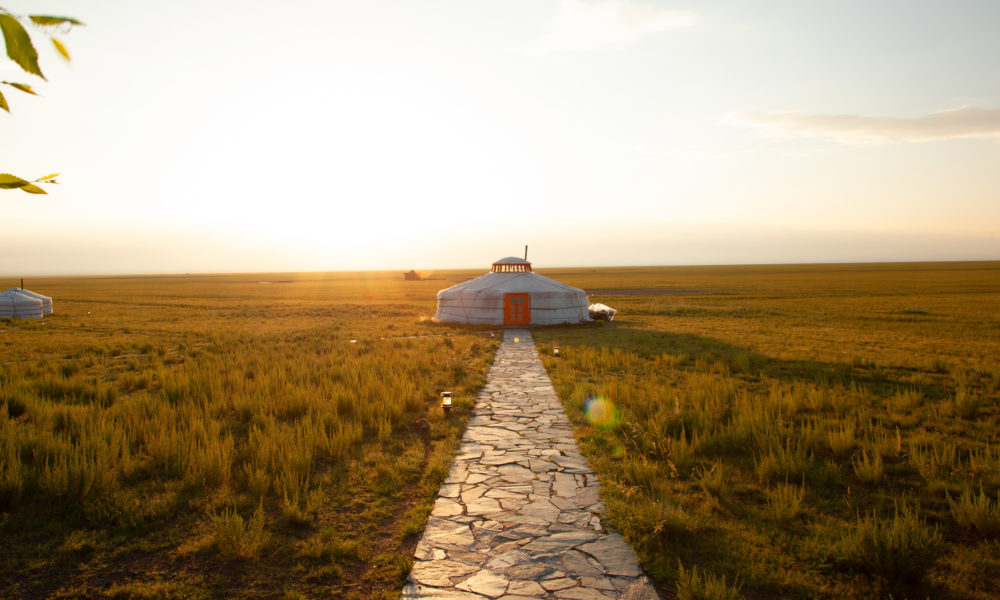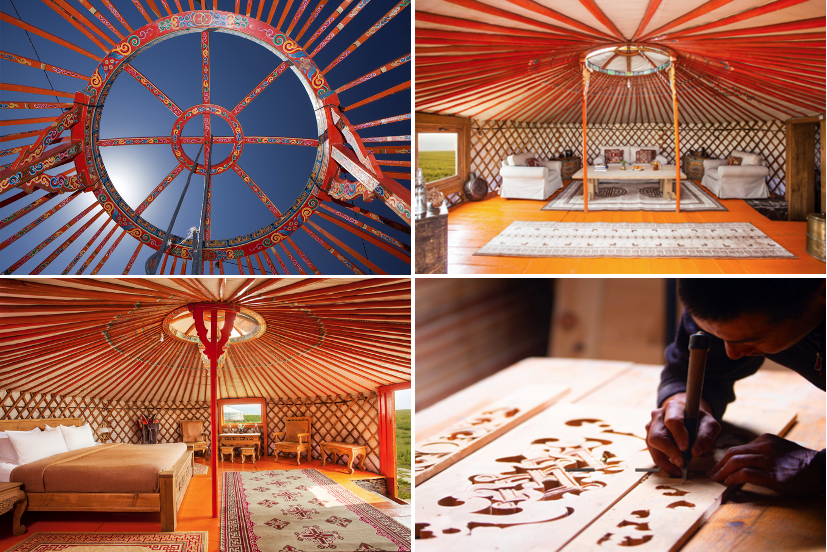The ger (pronounced ‘gaire’) presents a lovely window into the history and culture of Mongolia’s nomadic people. Ger is the Mongolian name for the portable, round tent dwelling used by distinct nomadic groups in the steppes of Central Asia. Also called a yurt (from the Turkic lnaguages), ger are traditionally constructed of a supported crown (roof ring), roof poles, wood latticework walls, and covered with felt—the dome skylight is open, with a woodstove chimney, and the door faces south. A marvel of ingenuity, the ger heartily withstands harsh winter winds, and radiates warmth within its insulation. The following facts about the ger are yet more intriguing.
1
The earliest version of the ger was assembled more than 3,000 years ago as a form of teepee, with its characteristic rounded shape. Its earliest recording comes from Herodotus, who described the yurt dwellings of Scythian people roaming vast open expanses of the Black and Caspian seas. However, petroglyphs discovered in Minusinsk, Russia, depict rounded, conical yurts—and these carvings date to the late bronze age.
2
Gers traditionally are about 16 feet in diameter, yet we know that they have long been constructed much larger. Historical accounts reveal there were three forms of dwellings during the Mongol Empire: pavilion-like tents with pillars decorated with gold leaf and fabrics embroidered with colorful patterns sewn with threads made of tendon; smaller collapsible gers, compact and easy to assemble and disassemble; and large non-collapsible gers on carts, some of which had golden steps at their entry.
3
The felted wool used to cover gers is naturally antimicrobial, anti-fungal and water resistant due to lanolin secreted by the glands of wool-bearing animals. Yet Mongols traditionally used ewe’s milk and tallow to further waterproof their gers.
4
A white ger was seen as a symbol of status. However, because white felt is extremely rare—as it requires an enormous amount of white wool—13th-century chronicler William of Rubruck reported that Mongols used powdered bones, chalk and white clay to whitewash their gers.
5
Research has shown that Mongolians are not lactose intolerant due to fact that their traditional dwelling is made out of byproducts of the livestock they raise, and also serves to house an array of dairy products all year rounds.
6
Chinggis Khan famously united the nomadic tribes of the Mongolia plateau and led them to establish the largest contiguous land empire in history. Yet the most challenging dimension of any military campaign is sustained support of one’s troops once deployed. The Mongol’s incomparably accomplished their feats of conquest by being a “vast city on the move.” Their gers being so quickly set up and taken down, they traveled en masse with a cavalry as many as 50,000, bringing with them 30,000 family members, 40,000 fresh horses, 100,000 sheep and goats for milking, and 75,000 oxen and camels. Thus they were their own supply chain, and easily lay siege to kingdoms.
7
The Khitans were a para-Mongolic people from Northeast Asia who from the 4th to the early 13th century inhabited an area spanning parts of modern Mongolia, northeast China and far eastern Russia. From historical documents, we know that they occupied two types of trellis-walled yurts: a simple, collapsible, low-status yurt with a rounded, conical roof; and a high-status blue-colored pavilion-like yurt with arched roof struts and a pronounced dome-shaped roof-wheel.
8
Erdene Zuu Monastery, the first Buddhist monastery in Mongolia, was the site of the largest ger ever built. Named Bat-Ulzii, the ger was assembled in 1658 for a gathering of nobles. Almost 30 feet high and 65 feet in diameter, its base remains inside the walls of the monastery to this day.
9
Gers are extremely mobile and compact. They can be dismantled and assembled in as little as 30 minutes, and one can be loaded onto only two or three Bactrian camels, depending on furnishing.
10
During 13th and 14th centuries, Khans and Mongol generals utilized gers constructed atop carts. Some of these were large structures requiring as many as 22 oxen to pull the cart when changing camp.
Three Camel Lodge enchants guests with our luxuriously appointed classic ger. Cozy wool carpets, thick camel-hair blankets, and furniture carved and painted by hand adorn each ger with authentic comfort. Discover Our Ger Accommodations Here.


